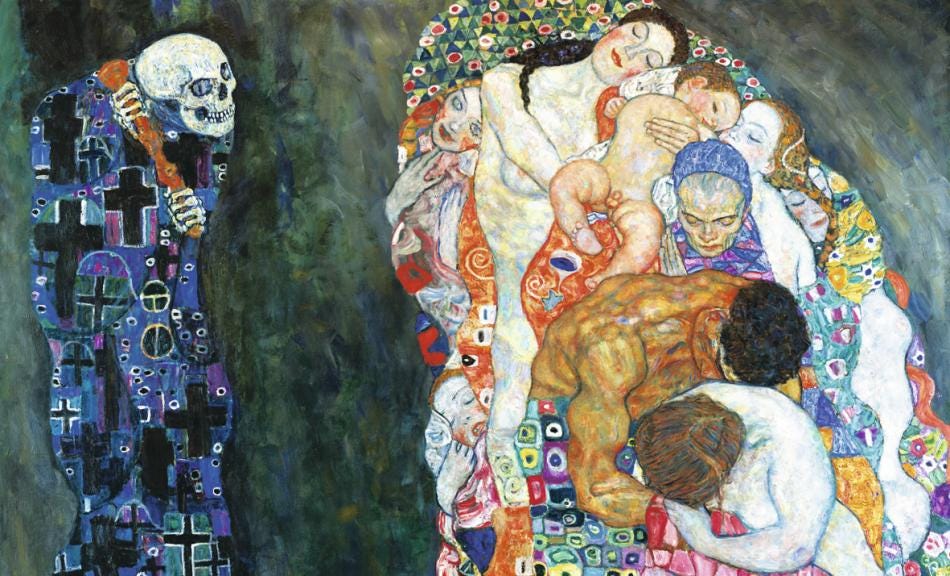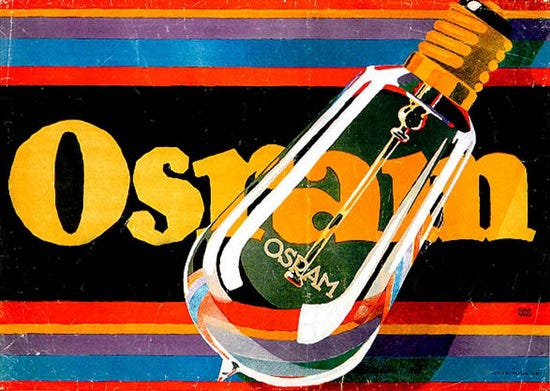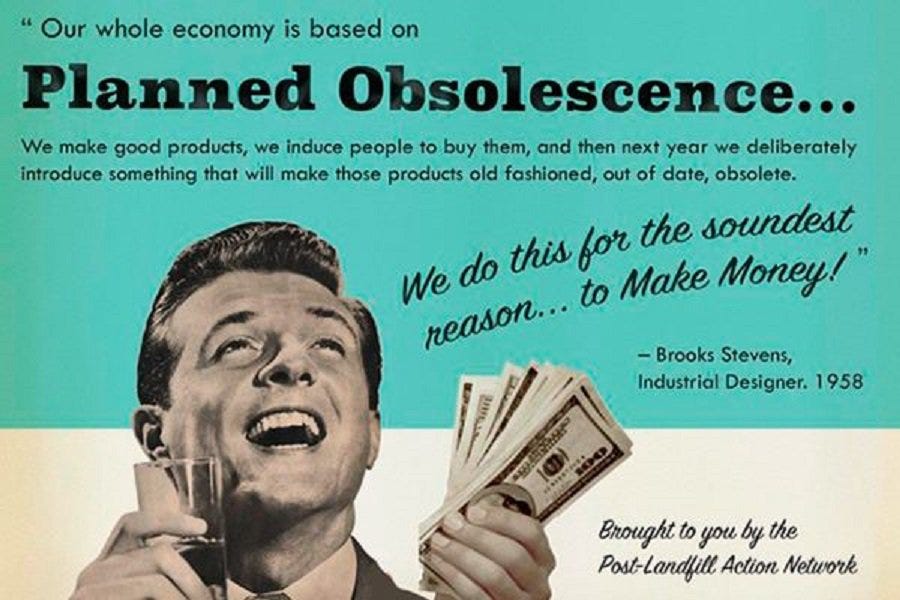Gravity's Rainbow - Part 4 - Chapter 3: Planned Obsolescence
Analysis of Gravity's Rainbow, Part 4 - Chapter 3: Eddie Pensiero's Haircut, Happyville and Pain City, The Story of Byron the Bulb
Lycanthropophobia has worked its way into the psyche of the people. While some of the Nazis readily gave up, many went into hiding. Others, known as Werewolves, refused to give up the fight and continued terrorizing the German people. Even some who went back into hiding, like Blicero who “had grown on, into another animal . . . a werewolf . . . but with no humanity left in its eyes” (3.17, pg. 486), possessed this lycanthropic connotation. The werewolf, with its viciousness and indiscriminate post-‘transformation’ massacre as well as its docility and human-like characteristics at other times, is a perfect representation of the post-WWII Nazi. They have either remained their vicious selves, unwilling to transform back, or have hidden away among the other humans until that opportunity to arise returns again.
Pfc. (Private First Class) Eddie Pensiero,1 part of the 89th Division, is here in Germany along with many other Americans who have been tasked with the country’s liberation. Pensiero has an innate ability to ‘read’ the sine and cosine wave patterns of people’s shivers, aligning him with many of the ‘freaks’ in Psi-section at the old White Visitation with their odd abilities, plus with those “like Säure Bummer [who] reads reefers, […] Miklos Thanatz [who] reads whipscars,” (641) Slothrop who reads the various symbologies of the Zone, and Pirate who reads and alters dreams. And while those others were used by Them within the realms of intelligence and surveillance, occasionally we will see those like Pensiero, whose abilities have either gone unnoticed or deemed unsuitable, who are merely used for the basest purposes of the war.
The Sergeant of the 89th Division, Howard “Slow” Lerner,2 tells Pensiero that a certain Colonel wants a haircut — cutting hair being one of Eddie’s other talents. So, he goes over to the Colonel who sits below a lightbulb — a very specific lightbulb who/which we have seen before, but we’ll get to that — that is being powered by another Private, Paddy ‘Electro’ McGonigle, “who sits back in the shadows hand-pedaling the twin generator cranks” (641) which are connected directly to the single bulb. McGonigle has a talent similar to Pensiero’s, but instead of being able to read wave-form patterns, he subconsciously transmits them as he is currently doing here with the imperceptible changes in the bulbs illuminations. This would typically be something that Pensiero would read, but currently he is entranced by “Somebody close by, out in the night, […] playing a blues on a mouth harp” (642). It is Slothrop. It could be that this section either takes place before Slothrop’s full fragmentation, thus placing the 89th Division close to Slothrop in the German wilderness of 4.1, or that Slothrop’s fragmentation had already occurred, meaning his spirit can now be heard and ‘read’ within the new Zone. I tend to believe it is the latter.
Slothrop’s music, whether or not he had fragmented by the time the 89th Division is listening, does represent something that can be ‘read’ in this newly formed world, and similarly, the Cosmic Bomb(s) has/have altered how we will now ‘read’ the world: “‘Do you suppose something has exploded somewhere? […] somewhere in the East? […] Yes, Private, the colors change, and how! The question is, are they changing according to something? Is the sun’s everyday spectrum being modulated? Not at random, but systematically[?]’” (642). The new Zone is leaving behind tangible and sensorial signs of what has happened. Our natural world has been altered into something artificial, where even the sun’s very spectrum is no longer natural. For, with the bomb(s) having been dropped, we have now created our own personal Sun. With the growing speed of Rockets that we would see evolve out of this post-WWII world, the Sun itself would bear no truth given a Rocket would now be able to kill someone in the future or the past — launched one day, traveling part way around the world into a time that has not yet passed for those who launched it, or backward into a time that did pass many hours ago, killing those who did not get to experience the future that their killers were able to see. Slothrop’s harmonica reminds us to wade through that same ‘shit’ which he once did in order to understand how these emerging, changing, or dead symbols represent the artificiality and the villainy of the world in which we now live.
And speaking of wading through ‘shit,’ the Colonel who Pensiero is giving a haircut to is from Kenosha, Wisconsin — the same Kenosha as the ‘Kenosha Kid’ which altered its connotations in Slothrop’s mind as he was drugged (with Sodium Amytal) by the White Visitation, leading him to his vision at the Roseland Ballroom (1.10). This Colonel could possibly be the named ‘Kenosha Kid,’ but I think the names inclusion is simply to remind us of the above: where Slothrop began his journey and what the search for the harmonica is asking us to do. And those with the talents to ‘read’ and/or ‘transmit’ the frequencies have an obligation to do so. Currently, Pensiero is unknowingly recording this information in the haircut itself; it is too soon to really understand the ‘message’ that he is hearing, but he subconsciously understands what is being told by McGonigle and the Lightbulb above.
As the Colonel continues yapping, he begins having a vision of his own where he is known as ‘Skippy’ and the other man in his vision is known as ‘Mister Information.’ Mister Information tells him about the pointsmen, the same people in power who we have discussed before, as well as Pointsman’s namesake. These are men, “wearing a white hood” (644) reminiscent of Ku Klux Klan members, who “[put] in very little work and makes big things happen, all over the world” (645). Whereas the job of the actual pointsmen is to pull a lever to switch the train onto another track, our symbolic pointsmen do this menial amount of work which sends a cascade down to alter history to their liking. In the example that Mister Information is providing, the two current tracks that are being chosen between are tracks to Happyville and Pain City — representatives of the current lie we are being told. Pain City is where we are and where we have been, the War: an explicit and apparent place of mass death and violence. Happyville is the place we are heading, the post-War Zone — a place where we can live in ignorance and bliss, for the violence and death is now ‘invisible.’ Instead of Germany stating its ‘Final Solution,’ instead of armies fighting and dying for the cause that they believe is right, instead of bombs dropping in major cities whose names we know well, we have this invisible death. This death stems from the world They were attempting to create with the War. It is where people will die in small cities or countries which we as Westerners do not care or even know about, where industry will be rebuilt across borders that do not have labor laws or the call for a living wage, where drugs can be purposefully trafficked into communities that They deem dispensable so that we can imprison these same populations (if they don’t die first) and use them for more labor unto death, where the inability to live fulfilling lives or to live without the stress of modern existence will lead to skyrocketing mental health crises and suicide rates. All this death is easy to swallow though. We don’t have to see the gore or the tears; we don’t have to hear the bombs or the screams. Instead, we can say it is just the sad reality of life on this Earth, and move on.
And in this otherworldly version of the coming world, Happyville, Laszlo Jamf steps out of the darkness to meet the Colonel: “the men have come from very far away, after a journey neither quite remembers, on a mission of some kind” (647). They are both pointsmen of some sort — ones who have been rendered immortal in the nature of this existence. Jamf has set the precedence for a number of things such as the development of addictive or controlling drugs, the experimentation on a population in order to develop newer means of control, the creation of plastics which would increase profits and further bind the human with the machine, and so on. The Colonel is someone who can and will bring about these desires through the act of War, likely representing the coming Cold War as a means to do so (drugs brought in via Vietnam, the Middle East, and South America; experiments such as MK Ultra, anti-communist psychological operations, or perfecting methods of torture; new products and plastics such as the coming use of more powerful, less detectable missiles, chemicals like Agent Orange, or even less direct acts of death through PFOS and its convenient, likely deadly — or at least harmful — capabilities).
While this story or vision is going on in the mind of the Colonel, another one is being told from above him. That bulb which McGonigle is powering is not just any bulb, it is the same one which told a story to Franz Pökler when he was in his cell at Nordhausen (3.11, pg. 427). The bulb is both alive and immortal; it has survived for a number of decades up to this point, never dimming or going out. The bulb, named Byron, now tells us and those around it (with its wave-form communication) The Story of Byron the Bulb, another foretelling to the coming world so prevalent in Part 4.
Byron was manufactured in Berlin by Osram, but there was some controversy in where his birthplace would be (even involving the father of Géza Rózsavölgyi: the man who Mexico tormented at Twelfth House in 4.2). The birth of Byron was determined by the ‘Higher Power(s)’ because, it turns out, "There is a Bulb Baby Heaven" (647). The supposed heaven, however, is a mere ‘satire’ of Big Business, meant to represent the bureaucratic measures that go into determining a new product’s origins, capabilities, and, as we will see, incapabilities. The industries (the ‘Higher Powers’) who have a hand in this creation are ones we know well — the infamous IG Farben and the recently discussed Siemens (Lyle Bland was on the board of directors at Siemens which used concentration camp labor; and we know enough about IG Farben’s evil already, though it should be remembered that Bland and Jamf had major ties to it). The one thing that these corporations want to do is to provide "the appearance of power […] without the reality" (647). On the surface, this shows that they want to ensure that the people who purchase their products or those who work for them have the illusion that they possess some form of power — whether that be of choice, ability, position, etc. — but more specifically, it is a revelation on the planned obsolescence present in the Phoebus Cartel3 which literally designed lightbulbs that would die early in order to increase the profit margins of the industries that produced them. And of course, this can be tracked far further than the mere lightbulb, which is what Byron’s story will help show.
The various bulb babies who were in Byron’s lot in Bulb Baby Heaven had a fascination with roaches, a creature that their innate ability helped scare away. The roach being a symbol of filth and decay is something we desire to keep at bay just as we desire to keep death at bay especially with the introduction of the Rocket. These bulbs, then, are being built to keep ‘death’ at bay only for as long as necessary until we regain that fear once the light burns out, forcing us to go back and buy another. It is a form of and symbol for commodified life and death. Byron’s song is a call-to-action for a crusade against the Phoebus Cartel or any ‘cartel’ (the Rocket Cartel, perhaps?) which is commodifying this idea, because remember, Byron, with his immortality, is proof that this ideology is a planned obsolescence, not a natural decay.
Byron, once born, realizes that he is immortal. At first, in Heaven, his desire to fight back stemmed from the lot of them being controlled, but as "One by one […] the other bulbs burn out," (649) he learns his first lesson: love. He is not going to be fighting for himself, because he is immortal. Instead, as friends and loved ones are purposefully stripped from their life in order to reduce any will to fight back while also increasing the profit margins of those making these decisions, he will be fighting for the people — just as Pirate, Katje, and the Counterforce decided to do (3.24).
But sometimes love is not enough to push the fight forward — "After Love, then, Byron’s next lesson is Silence" (650). Because now, he is being watched. As his lifespan surpasses 600 hours (and eventually 800), agencies begin to realize that he is an anomaly. He is tested and kept under surveillance because They believe "that through no bulb shall the mean operating life be extended. You can imagine what it would do to the market if that started happening" (650). The implication here is that public knowledge of such an anomaly would lead to an understanding that this ‘appearance’ of power was just an appearance — not the reality which we once believed. Adding to that, even if Byron went unnoticed by a massive majority of the population, his impact on the statistical data around the life of lightbulbs as a whole would render that mean-value as false for nearly every other bulb, thus calling attention to something fishy. Planned obsolescence therefore requires complete participation; every individual must believe and see that they have been given a natural, equal opportunity.
However, bulbs do begin taking notice, and word starts spreading. Similarly, Pirate and his cohort noticed a statistical anomaly within their world, seeing a planned obsolescence of the people and thus, like the bulbs are now doing, planning to overcome the system that causes this. As we see though, "Anyone shows us the meanest hope of transcending and the Committee on Incandescent Anomalies comes in and takes him away" (650). This committee, again the CIA, acts as an anti-revolutionary force in the post-Zone world. We first saw them as the Committee on Idiopathic Archetypes, suppressing any means to achieve wealth and power outside of set systemic means (4.1). Now, they are suppressing the people (the bulbs) as a whole in order to prevent a mass understanding and subsequent uprising regarding the fact that all of this death, decay, and oppression, was planned from the start. Pirate and the Counterforce will likely be forced to fight against similar agencies.
Byron is transferred to a facility "where suspicious bulbs can be monitored easily" (651). While here, after now passing 1000 hours of illumination, his life must be put to an end. The CIA’s cost-benefit analysis has deemed that any sort of detriment that his death may pose on the People’s (Bulb’s) view on Them, or the state of the world in general, is far less harmful than allowing his prolonged life to alert the People of the reality in which they live. So, the CIA sends out a hitman, but somehow, through a chain of incredibly lucky events, Byron is rescued.
It turns out that Lyle Bland himself (still alive since we have gone a bit backwards in time to the earlier stages of Byron’s life: pre- and early-WWII) was a part of this bulbsnatching quest. Bland and Phoebus discovered "that consumers need to feel a sense of sin" (652).4 The Market has imposed a sense of sin for the accumulation of necessities outside of the Market itself. Therefore, light being a ‘necessity,’ bulbsnatching (or theft of necessities in general) is unacceptable in the eyes of the producers and controllers. The producers therefore had to make it unacceptable in the eyes of everyone. Similarly, we now see ‘theft’ of food as a sin, even among those who quite literally cannot afford it. We see advertisements catering to the ethos of the consumer which show workers like us in an industry such as Walmart. And if we were to steal from Walmart, then we would be putting their jobs or their pay at risk, would we not? With all of these pieces of propaganda telling us that working outside the Market is sinful — whether it be that literal theft or even something as natural as living ‘off the grid’ — well, people really have begun to believe it as the truth. And it is more than a belief: we quite literally cannot remove the idea from our head despite knowing it is not true.
As the hitman continues his search, he moves through a number of scenes in Nazi Germany, not finding Byron, and eventually being reassigned to find another immortal bulb. But Byron does not cease his own goal in forming "solidarity against the cartel" (653). This is again like Pirate forming a group solidarity against the Elite. In the realm of the Bulbs, "Phoebus has restricted Bulbs to this one identity," (653) producers of light. And in our world, They — the Elite — have restricted us to one identity as well: workers, cogs in the system. And as workers, or as producers of light, a solidarity can be formed in order to allow those many other identities to come to fruition and flourish.
On top of Phoebus’ control over the bulbs’ lifespan, they also sought to maintain control over the power grids, for each industry inevitably bleeds over into the other. The industries are invariably held in balance by the one which comes before and after it in the chain, and each one provides the requirement of another industry’s existence, both working in tandem to increase profits for the other, those profits largely ending up in the hands of someone controlling both. In the story’s context, these would be the leaders within the industries of the bulbs and those of the power grid, who themselves would also suppress other, less profitable, industries from causing a reduction in Their market. Therefore, the possibility that any person could remove themselves from the need for bulbs and the power grid itself is a massive threat to those who run these industries, so the production of candles must be reduced. Tallow is thus redirected from the production of candles to the production of soap — soap being an industry that does not yet detract from another. But wait, there’s more! Yet another industry limits the overly planned obsolescence of bulbs, for bulbs use tungsten as a part of their filaments, and tungsten itself needs to be at least available enough to provide tungsten carbide for the War industry (tungsten carbide being largely used to produce things such as drill bits and cutting tools used in machining industries). Every industry is so carefully tied together with another, held in such precarious balance, that there should be no surprise They could not let someone like Byron survive.
And these are just a few of the connections that surround one mere product — the Bulb. Byron realizes that there are "other kinds of electric appliances, in homes, in factories and out in the streets," (654) which have similar webs around them. The number of industries surrounding one product, let alone every product, makes "His youthful dreams of organizing all the bulbs in the world seem impossible now" (654-655). He believes that there is no possible way such a nearly perfected complex of industry can be tampered with by someone as menial as him. Maybe, instead of a more ‘active’ activist, he could be a prophet, dispensing the information to the people, producing a proletarian mass consciousness. However, prophets like these do not often make it very far, for "they are either killed outright, or given an accident serious enough to make them stop and think" (655). For instance, Pynchon may be literally thinking of his friend Richard Fariña, a political activist and revolutionary figure, who mysteriously ‘died’ in a motorcycle accident.5 And on top of Fariña, we see figures such as Malcolm X, Martin Luther King Jr., Che Guevara, Rosa Luxemburg, Leon Trotsky, and Patrice Lumumba, all fighting for human rights and a reduced imposition of the system on the individual/community, subsequently murdered. So instead of subjecting himself to imminent death, Byron relents. He believes he cannot change a thing.
Back in Happyville, the Colonel who saw Jamf invade his dream now sees Jamf walking away. Laszlo’s job is done. He, a man bent on developing new forms of control, has imposed yet another form. Likely, he believes his job, even from the other side of the grave, is done. Byron has been subdued. Or has he? For now, above the Colonel, Byron still sends out his signals and stories by using the ‘freaks’ around him. McGonigle powers the bulb with his own ability, Byron transmits his story, and Pensiero, shears poised above the Colonel’s jugular, interprets the truth. All that’s left to do now is to act.
Up Next: Part 4, Chapter 4
Don’t worry, it’s not that you’re not remembering who this is, we haven’t met him yet; nor have we met any of the characters in this chapter specifically (outside of the references to those like Jamf or Bland). This chapter acts as a sort of standalone story-within-a-story-within-a-story that adds to the themes of Part 4 so far as well as serving as a summary of the novel to this point.
Pynchon’s next publication, after Gravity’s Rainbow, was Slow Learner (1984). It was published a full 11 years after Gravity’s Rainbow and was still not even a full novel (the next novel, Vineland, wouldn’t come for another few years in 1990). Slow Learner was an essay about the process of and his feelings toward his first three novels, V., The Crying of Lot 49, and Gravity’s Rainbow, along with five short stories which he had written before these novels. His essay also has commentary on why the stories he wrote and that he was republishing here were technically ‘failures.’
I don’t think there is really any thematic reason for the name of his next work to be included here. There could be, but I just think it’s a fun Easter egg that he planted. The collection is worth reading, mostly for the essay, but also because it is cool to see Pynchon’s evolution as a writer.
For some reason the Weisenburger companion states that the Phoebus Cartel was fictional. This is definitely not the case. I’m assuming there wasn’t much information on them when the companion was written, but they were very much a real organization.
This coming analysis on the phrase "consumers need to feel a sense of sin" (652) is largely attributable to my friend and co-worker who also helped me analyze the Roland Feldspath haunting in 2.5.
I discussed this a lot more in the first post (1.0) since the dedication for Gravity’s Rainbow was for Fariña.









